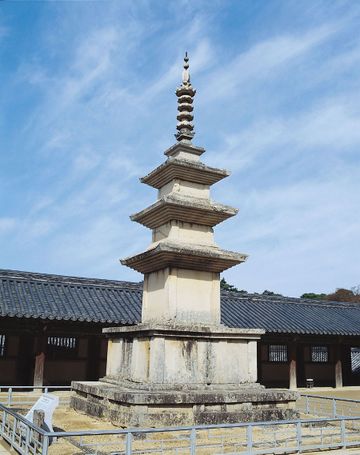경주 불국사 삼층석탑
| 경주 불국사 삼층석탑 Three-story Stone Pagoda of Bulguksa Temple, Gyeongju |
|
 경주 불국사 삼층석탑, 국가문화유산포털, 문화재청. |
|
| 대표명칭 | 경주 불국사 삼층석탑 |
|---|---|
| 영문명칭 | Three-story Stone Pagoda of Bulguksa Temple, Gyeongju |
| 한자 | 慶州 佛國寺 三層石塔 |
| 주소 | 경상북도 경주시 진현동 불국로 385 |
| 지정(등록) 종목 | 국보 제21호 |
| 지정(등록)일 | 1962년 12월 20일 |
| 분류 | 유적건조물/종교신앙/불교/탑 |
| 시대 | 통일신라 |
| 수량/면적 | 1기 |
| 웹사이트 | 경주 불국사 삼층석탑, 국가문화유산포털, 문화재청. |
|
|
|
해설문
국문
대웅전과 자하문 사이에 다보탑(국보 제20호)과 동서로 마주보고 있다. 탑의 원래 이름은 석가여래상주설법탑(釋迦如來常住說法塔)으로, 석가탑이라 줄여 부른다. 과거의 부처인 다보불(多寶佛)이 현재의 부처인 석가여래가 설법할 때 옆에서 옳다고 증명한다는『법화경』의 내용을 두 탑으로 구현한 것이다.
2층으로 된 바닥돌 위에 3층으로 몸돌을 올린 전형적인 통일신라시대 석탑으로 감은사지 삼층석탑에서 시작된 통일신라시대 석탑이 이 탑에서 가장 정형화되고 세련미의 절정을 보여준다. 바닥돌에는 면마다 모서리 기둥과 2개씩의 안기둥을 새겼고, 몸돌에는 모서리 기둥만 새겼다. 지붕돌은 모서리를 치켜 올려 경쾌하게 날아오르는 듯한 느낌을 더한다. 머리장식은 1973년 남원 실상사 동ㆍ서 삼층석탑(보물 제37호)의 머리장식을 본떠서 복원한 것이다. 탑 주위로 둘러놓은 주춧돌 모양의 돌에는 연꽃무늬를 새겼는데, 이를 부처님의 사리를 두는 깨끗한 곳이라는 뜻으로 해석하기도 한다.
1966년 탑을 수리할 때 2층 몸돌에서 『무구정광대다라니경(無垢淨光大陀羅尼經)』을 비롯한 사리장엄구(舍利莊嚴具, 국보 제126호)*가 출토되었다. 석가탑 출토 무구정광대다라니경은 너비 약 8cm, 전체 길이 620cm의 두루마리 형식으로 불국사 건립 시기인 경덕왕10년(751)에 간행된 세계에서 가장 오래된 목판인쇄물이다.
- 사리장엄구(舍利莊嚴具) : 사리함과 사리병을 비롯해 사리를 봉안하는 모든 장치
영문
Three-story Stone Pagoda of Bulguksa Temple, Gyeongju (Seokgatap Pagoda)
The three-story stone pagoda of Bukguksa Temple, also known as Seokgatap (“Pagoda of Sakyamuni Buddha”), is presumed to date to the temple’s establishment in the mid-8th century during the Unified Silla period (668-935). This pagoda represents the Buddha of the present, Sakyamuni, and forms a pair with the adjacent stone pagoda, which represents the Buddha of the past, Prabhutaratna.
The pagoda consists of a two-tier base, three sets of body and roof stones, and a decorative top. The corners of the base and body stones are carved to look like pillars, and the undersides of the roof stones are carved into tiers. The decorative top was newly made in 1973 as the original was missing. The overall design is representative of Korean stone pagodas.
Seokgatap has been dismantled for repair and restoration four times in its history. During a repair in 1966, a copy of the Great Dharani Sutra dating to the early 8th century was found inside the pagoda. It is considered to be the oldest woodblock printing in the world.
- A pagoda is a symbolic monument enshrining the relics or remains of the Buddha. Although not all pagodas contain the true remains, they are nonetheless worshiped as sacred places that enshrine the Buddha.
- ..., which resemble the pillars and eaves of a traditional wooden building.
- The original decorative top had been lost, and the current one was made in 1973 by referencing a different pagoda from the same period.
- The pair of pagodas located in the courtyard of Bulguksa Temple’s main worship hall are meant to symbolize the Buddha of the present, Sakyamuni, and a Buddha of the past, Prabhutaratna (Buddha of Abundant Treasures), who appears to verify the truth of Sakyamuni’s teachings in the Lotus Sutra. The pagoda to the west (left) is known as Seokgatap meaning “Pagoda of Sakyamuni,” while the one to the east (right) is known as Dabotap, meaning “Pagoda of Abundant Treasures” in reference to Prabhutaratna. The past is symbolized by the east, the present by the center, and the future by the west. The realm of the future is symbolized by the adjacent Geungnakjeon Hall.
- It was dissembled and repaired in 1036 following a series of large earthquakes which had made the structure unstable. During the Japanese invasions of 1592-1593, the pagoda collapsed and was reassembled and repaired. In 1966, the pagoda was damaged when someone attempted to steal the relics enshrined inside it. This prompted repairs which led to the discovery of a reliquary and repair records dating to the 11th century, which are valuable in the understanding of the temple’s history. Also discovered was a woodblock printing of the Great Dharani Sutra dating to the mid-8th century, which is considered to be the oldest printed text in the world. From 2011-2017, the pagoda underwent an extensive survey and restoration.
- 「무구정광대다라니경」의 간행시기에 관한 재검증 연구 - 국문에 언급된 것과 달리, 무구정광대다라니경은 704~751 사이에 만든 것이면 706년으로 추정되는 연구도 있습니다. 사실상 언제 간행된 건지 몰라서 국문 내용이 틀린 것 같습니다. 다른 자료에 751년 경이라고 하는데 여기서는 '경, 무렵' 이런 말이 없어서 문제가 되는 것 같아요.